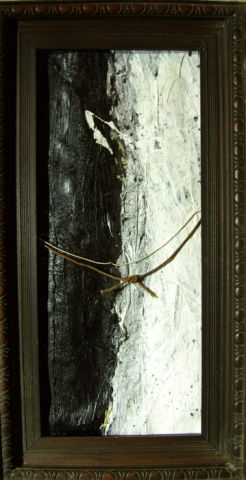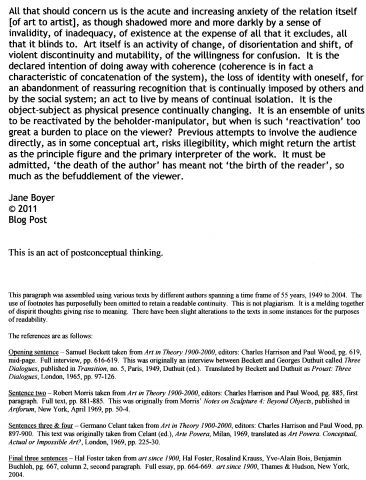All that should concern us is the acute and increasing anxiety of the relation itself [of art to artist], as though shadowed more and more darkly by a sense of invalidity, of inadequacy, of existence at the expense of all that it excludes, all that it blinds to. Art itself is an activity of change, of disorientation and shift, of violent discontinuity and mutability, of the willingness for confusion. It is the declared intention of doing away with coherence (coherence is in fact a characteristic of concatenation of the system), the loss of identity with oneself, for an abandonment of reassuring recognition that is continually imposed by others and by the social system; an act to live by means of continual isolation. It is the object-subject as physical presence continually changing. It is an ensemble of units to be reactivated by the beholder-manipulator, but when is such ‘reactivation’ too great a burden to place on the viewer? Previous attempts to involve the audience directly, as in some conceptual art, risks illegibility, which might return the artist as the principle figure and the primary interpreter of the work. It must be admitted, ‘the death of the author’ has meant not ‘the birth of the reader’, so much as the befuddlement of the viewer.
Jane Boyer
© 2011
Blog Post
This is an act of postconceptual thinking.
This paragraph was assembled using various texts by different authors spanning a time frame of 55 years, 1949 to 2004. The use of footnotes has purposefully been omitted to retain a readable continuity. This is not plagiarism. It is a melding together of dispirit thoughts giving rise to meaning. There have been slight alterations to the texts in some instances for the purposes of readability.
The references are as follows:
Opening sentence – Samuel Beckett taken from Art in Theory 1900-2000, editors: Charles Harrison and Paul Wood, pg. 619, mid-page. Full interview, pp. 616-619. This was originally an interview between Beckett and Georges Duthuit called Three Dialogues, published in Transition, no. 5, Paris, 1949, Duthuit (ed.). Translated by Beckett and Duthuit as Proust: Three Dialogues, London, 1965, pp. 97-126.
Sentence two – Robert Morris taken from Art in Theory 1900-2000, editors: Charles Harrison and Paul Wood, pg. 885, first paragraph. Full text, pp. 881-885. This was originally from Morris’ Notes on Sculpture 4: Beyond Objects, published in Artforum, New York, April 1969, pp. 50-4.
Sentences three & four – Germano Celant taken from Art in Theory 1900-2000, editors: Charles Harrison and Paul Wood, pp. 897-900. This text was originally taken from Celant (ed.), Arte Povera, Milan, 1969, translated as Art Povera. Conceptual, Actual or Impossible Art?, London, 1969, pp. 225-30.
Final three sentences – Hal Foster taken from art since 1900, Hal Foster, Rosalind Krauss, Yve-Alain Bois, Benjamin Buchloh, pg. 667, column 2, second paragraph. Full essay, pp. 664-669. art since 1900, Thames & Hudson, New York, 2004.

